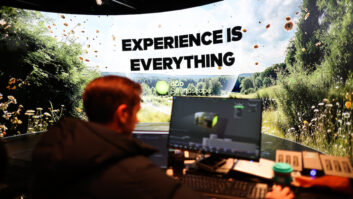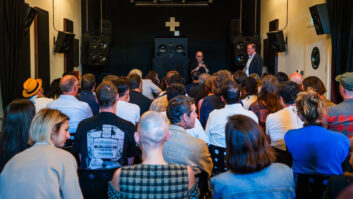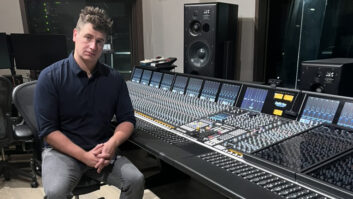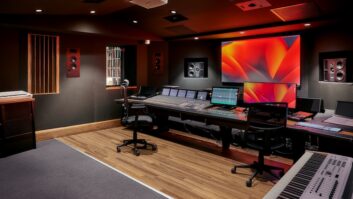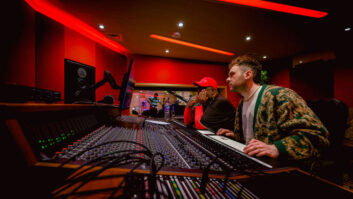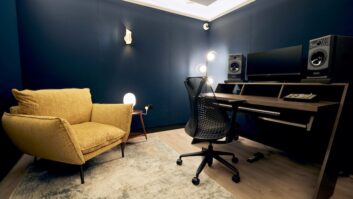Howie B. has been something of a ubiquitous figure in popular music the past few years, particularly in Europe. The producer/engineer/mixer/composer/DJ has turned up on all sorts of proj-ects in his various capacities: He’s worked on three Bjork albums; Robbie Robertson’s acclaimed Contact From the Underworld of Red Boy CD; with Ry Cooder on the soundtrack for Wim Wenders’ film The End of Violence; producing Sly & Robbie’s recent album, Drum and Bass Strip to the Bone; helped out on U2’s Pop album and the group’s megatour that circled the globe supporting that record; and he’s written with, produced, remixed or doctored tracks by the likes of Brian Eno, The Passengers, Tricky, Everything but the Girl, Baaba Maal, Soul II Soul, Major Force and many others. Both his writing and production have been heavily influenced by his work as a DJ in London clubs through the years, and though he has increasingly moved into producing other acts and composing his own music, he continues to spin discs whenever he can. Indeed, when we spoke by phone in early March, he was in Berlin promoting his intriguing new all-instrumental CD, Snatch, and preparing to go on a whirlwind DJ tour that was to take him to Milan, Paris and Brussels.
Snatch, on the Palm label, shows many sides of Howie B.’s artistry. As you’d expect from a DJ, the grooves are fat (and phat), the loops and samples mesmerizing and intoxicating, the melodies and rhythms a polyglot that spans many genres. There is darkness, pathos and more than a little whimsy in the music, but also some very pretty melodies. Howie B. wrote, performed, recorded and produced the CD himself. It won’t be everyone’s cup of tea, but it’s difficult not to be swept up in its textural inventiveness and sonic weirdness. It’s surprising and unpredictable-which is how he likes to keep his DJ performances, too.
What do you typically do in a DJ show?
Well, I carry about three bags of records with me, which is about 150 pieces of vinyl. And it can range from playing something like a jig from the film The Wicker Man to James Brown to hip hop to dub and whatever.
Do you mix your own music in with that?
Not really. There’s an unwritten thing with DJs that you don’t play your own tunes. Sometimes I’ll play other people’s mixes that they’ve done for me, but usually, no. It’s more fun for me to play other people’s music.
Tell me a bit about how you made your new album-the elements you used, how you constructed it, what inspired it.
The main element was a physical and mental crash; that was the start. I was working too much, socializing too much and basically not looking after my soul. I’d been looking after too many other people’s souls, and I forgot to pay attention to myself. I’d just come off the U2 tour, I’d just finished a relationship with a woman and I wasn’t in a particularly good place. And the way I thought I could get out of that was to go into the studio and create, almost as a sort of self-help. So that was the fire; it was very personal. I’d never really focused on myself for such a length of time.
What is Chilli Mobile, where you made the record?
It’s a portable studio that a friend of mine, Nick Young, put together while I was on the U2 tour. It’s like a full studio, but you can take it anywhere in the world in two flight cases. It only takes me a few minutes to set up, and I can record and make music and make records. It’s got an Akai 3200 sampler, an H3000 SE effects box and SPX 1000 effects box, an M500 stereo gate, dbx 160 compressor. The sequencer I use on it is an Otari 1040 computer running C-Lab software. I’ve got an [Roland] MKS 70 rackmount [synth] and a Nord rack [synth] as well, controlled by a Yamaha mini-keyboard. I have three VCOs and one LFO, a Fostex R-8 8-track analog recorder, a DAT player, one record deck and one crossfade mixer, and two Mackie 16-channel desks linked together. It sounds like a lot of stuff, but it only cost something like Pound10,000-maybe $16,000 in America-to put it together. Compared to what’s normally at my fingertips in big studios, it’s not much really, and that was another challenge for me on this project to see how far I could take my ideas with the material limitations.
Some of what this project was for me was to get back to what I was doing eight, nine, ten years ago; get back to those moments when I didn’t rely on anybody else apart from me, and I had to do everything myself. The largeness of this life I’ve got, working with U2 and all these others…I needed to get back to basics and rediscover what I’ve got in me, find my music again, because I’ve been working so much with others.
I imagine these songs started all different ways-with a sequence, maybe, or a simple keyboard melody line.
All sorts of ways. Some of them started with a noise. Some of them started with me rubbing the stylus of the record deck. Some of them started with me crying in the studio. Some of them started with me staring at the wall. Some of them didn’t even start. [Laughs] It was a mad time for me. But once I got started and got to about the halfway point, then it was cool. I became quite sociable, I could talk to people again, and I started to actually enjoy myself. I think it’s the most difficult project I’ve done because, like I said, I didn’t rely on anyone except myself, and I really pushed myself. I didn’t lift the phone for help. I didn’t call in any other musicians…
And at this point you could probably make a helluva record calling up some of the people you’ve worked with through the years.
That’s right. I could’ve made the album of all bloody albums if I’d wanted to, but that wasn’t the intention. The intention was to get myself out of the shit, basically. And it worked. It helped me face up to my depression that I was experiencing and my low self-esteem. “C’mon, get on with your life, Howie!” Once I got to that point it became quite joyful and the music changed as well.
You’ve become known for your collaborations with a wide variety of musicians. Can you talk about how that developed?
I think for me it just happened socially through meeting people at a club or a bar or a park over the years. I suppose they liked what I did. Maybe they heard me DJ or they heard a 12-inch I did for some independent label-the Mo Wax stuff or the music I did for this Japanese label called Major Force. And they started askin’, “Fancy comin’ into the studio and workin’ with us?” For me, collaborating seemed like such a natural thing to do. I never went fishing in terms of looking for work in that area.
My collaboration with Robbie Robertson came about because he sent me a letter. I was in Dublin at the time, and I received this letter that was a poem about someone going on a journey, and at the end of it he wrote, “Will you come on a journey with me?”
Were you familiar with his work with The Band?
Oh yeah. I remember seeing The Last Waltz when I was 13, and I thought it was magic; I thought it was outrageous.
At first he said to me, “Will you come over to L.A. to work with me?” And I said, “No, I won’t go there. It’s not the place for me. I’ve been there once, and it wasn’t a pleasant experience.” So he came over to London. We’d never actually met, but he came over to London for a week and we recorded two tunes at Milo [Studios], where I do a lot of my work, and then we mixed them at Whitfield Street Studios. At the end of the mix he turned around and said, “Howie, this is magic. Since I came here to London, you have to come home with me to L.A. and we’ll do some more.” So I did, and we did some great work together. He introduced me to some crazy, crazy people. [Laughs]
Were you working at Robbie’s little room at the Village?
We were working there, and we had another room downstairs at the Village. It was a great time.
What did you do with Ry Cooder?
I wrote three songs with him, and then I mixed a few of his pieces for a film by Wim Wenders called The End of Violence. Through that I met Jon Hassel and Jim Keltner. It was a crazy and fun time.
Had you worked with Eno before you met Hassel? I really like the music they’ve made together.
Me, too. No, I met Eno earlier. They’re both characters. I’ve never seen them together, but I can imagine what it would be like to have the two of them in the studio.
As the years go on, Eno’s influence on so many different musical movements seems bigger and bigger.
That’s true. He’s a man who’s about giving life; that’s his sole concern. He’s incredible. He’s always got lots of different things going. He’s a great inspiration to me; not so much his music, but him as a person.
We’ve done some nice things together-The Passengers project, a Baaba Maal project. We jam together quite a lot at his little studio. I’ll go over there for two or three hours and we see what happens. We talk together, we eat together. We have a common interest in ladies’ bottoms…[Laughs]
How did your connection to Bjork happen? The two of you have made some interesting music.
Again, it was just social, meeting her in clubs around London. So she asked me to come in and do some engineering on her first album. I recorded most of the live tracks on the first album. Then on the second album she asked me to come in and write with her. I mixed that album and produced and wrote one of the songs on it. Then on the third album my role was to…I don’t know…I gave her a big kick to push her into a lot of different situations. I recorded the vocals on that album with her in various places in the world, ranging from Spain to Los Angeles to New York to London to France. Because when that album was being made I was on tour with U2, so she would fly to wherever I was. The tapes would arrive, and I’d go into a studio, get a balance up for her and we’d do vocals. It was a good little thing.
Is it hard to keep a consistent vision of a project when you’re working like that?
Not really. The vision was hers. I was pushing her to get that vision out of her. When I’m producing, I feel like it’s my job to push these people so that they don’t let themselves down; so they express themselves as best as they can. I was really pushing her on that album, maybe more than anyone had done with her before. We’d go in and do three or four vocals in one day, then I wouldn’t see her for two weeks and then I’d see her in another city, and so on.
Is there an element that unites all these artists you’ve worked with, from Bjork to Tricky to U2?
It’s like I said about Eno: They’re all life-givers. They’re interested in opening doors and challenging themselves. They’re experimenting and breaking the rules.
What was your role on the U2 tour? I know you were DJ’ing…
I was DJ’ing, I was musical director.
What does that mean?
I told them they were playing shit and that they had to get better. I rehearsed them each day for almost eight months. I’d change the arrangements of their songs and work with them as a band to get the best out of them. So that was one role-the MD. Then there was me as the DJ and there was me as live mixer. I was a front-of-house engineer with a guy called Joe O’Herlihy, who’s been with them for something like 20 years, since day one. That was the first time I’d ever done front-of-house sound. Joe took me on, and he was brilliant. We moved a lot of air. To work with a system that big was outrageous for me.
Personally, I wish they’d get out of the stadiums.
I agree with you, but Bono loves singing to a lot of people, and it’s amazing how well he can communicate with everyone, even way in the back of a stadium. This tour was a little different, too, because with the huge screen, it was almost like the back row had the best view. The best sound was in the back, as well.
It’s amazing how much sound what is basically just a trio and a singer can put out in a big place. The Edge alone is like a whole band.
He is. I learned something really interesting from Ry Cooder about that. I did the music for The End of Violence the week before I went on tour with U2. I was a little bit frightened, and I was asking his advice because he’s played a lot live. And he said, “Concentrate on them as a band, and make them play quiet. The quieter they play, the more air they will move.” And I didn’t really understand what he was saying at first. It wasn’t until I got into the tour that I realized what he meant. The first thing that happens on a tour is that each of the musicians comes up to you and says, “Turn me up! Turn me up!” [Laughs] And they were standing on this huge stage miles from each other and wanting to play as loud as they could. So in the end what we did was everybody got turned down and we moved them closer together and created a little circle, which they could then step out of, and that brought them together more as a band. It was a simple thing, but it came from Ry Cooder’s advice.
I know I’m not alone in having a hard time keeping up with what’s happening in the clubs, whether it’s trip hop or techno-ambient or drum and bass. What’s happening in the clubs right now? My sense is that everything is becoming more and more eclectic.
That’s right. It’s all over the place. It’s brilliant. The sets that I do are always fairly eclectic, and they have been for as long as I’ve been DJ’ing.
What’s a typical set for you?
I might start off with big beat, then maybe go to German techno. From there I could go into Italian lounge music, into English drum and bass and back into big beat. It can go quite a few ways. The club scene is very open right now. In London it’s big beat and drum and bass mostly. There’s also a hybrid of those two.
I’m not familiar with big beat.
It’s hip hop, but going at 120 bpm. It’s like house hip hop a bit. It’s usually got lots of guitars in it. It’s very up and has a tight edge to it. It’s difficult to define all these things because every week there’s someone that’s taken it a step further. Right now, The Propellerheads are the band that are on the big beat vibe.
What are you working on now?
I’m working with a band from Paris called Les Negresses Vertes. They’re brilliant. I’m halfway through an album with them. We started in this 1920s theater in Paris that’s not being used any more; set them up in there, brought my studio over. Actually, we set two studios up. We made a pre-production room and also made a recording room. The recording room was the theater. We did the pre-production on the little Fostex, rehearsing and rehearsing and working on arrangements. And then when we got it right, we’d move upstairs, soundcheck and record. We did that to 16-track 2-inch. It’s a great wee project I’m excited about.
I assume that when someone wants to work with you they’re expecting you’ll do some interesting sonic touches with them. When they ask me to produce them, they’re trusting me to really work with them. There aren’t going to be ground rules like, “All the songs have to be under three minutes,” or “All our songs are verse-chorus, verse-chorus.” If that’s what they want, then I’m not the right person. It might well end up that the music turns out that way, but if I’m given that restriction, there’s no point in having me there. There’s lots of guys to call for that kind of record, but it’s not me. This band, in particular, has given me some beautiful space, and I think they’re livin’ large because of it.
You’ve worked all over the world. What are your favorite studios?
Ry Cooder introduced me to Ocean Way. That’s a fantastic studio. Another one I liked was Fantasy Studios [in Berkeley, Calif.]. We rehearsed U2 in there for a week. There’s a studio in the south of Spain called El Cortijia where Bjork recorded her third album. I’ve recorded a few albums there; it’s a beautiful room. In England I love Milo Studios and Whitfield Street. AIR Studios in Lyndhurst is fantastic, too, though I’m actually fond of their smaller room more than the big, big one. The smaller room has this custom Neve that is the greatest-sounding desk ever.
What’s your current favorite piece of new gear?
It’s called the Notron. It’s a 4-channel sequencer that’s outrageous. I’m always looking for new stuff. But you know what, rather than coming in with new gadgets all the time-though I do that, too-what I’m looking for is a good new idea. Gadgets don’t help unless you’ve got good ideas.

